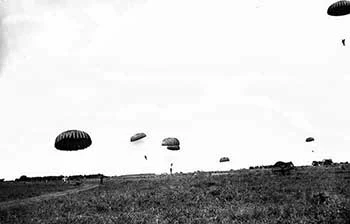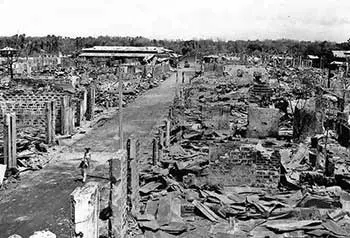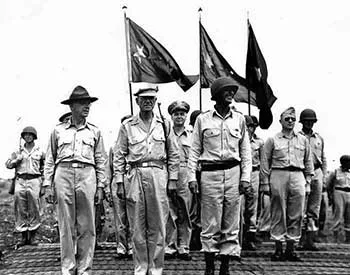The 11th Airborne Earns Rest in Lipa after Liberation of Batangas in 1945
[Topics in this article: 11th Airborne Division US Army, Lipa Batangas, US Army bivouac in Lipa, Mataasnakahoy Batangas, USO in Lipa, Colonel Masatoshi Fujishige, Battle of Mount Malepunyo, General Joseph Stillwell, Aparri drop]
On the last day of April 1945, the United States Army’s 11th Airborne Division – whose exploits are serialized in Batangas History – had successfully overcome the last Japanese defenses at the Malepunyo mountain range just east of the town of Lipa. This effectively ended the Japanese occupation of the Province of Batangas, and some 2,000 Japanese soldiers who somehow survived the battle managed to slip through American patrols to go into hiding in the upper slopes of Mount Banahao under Colonel Masatoshi Fujishige1.
For the United States 8th Army, in particular the 11th Airborne, undermanned and underequipped but tasked with securing Southern Luzon including the liberation of Batangas, the capture of Malepunyo finally meant some deserved rest. There was still the task of mopping up – i.e. rounding up Japanese stragglers in hiding – but by May the 11th Airborne was able to bivouac in Lipa. In his book, Major Edward M. Flanagan Jr. wrote:
“By the tenth of May the Division had regrouped and established a base camp in the vicinity of Lipa, maintaining outposts and patrols throughout a wide sector. The 11th of May marked another milestone in the career of the Angels (the nickname of the 11th Airborne). It was the first day since 31 January 1945 — a total of 101 consecutive days — that the Division had not killed a Jap. Since our entrance into Southern Luzon at Nasugbu, we had averaged 93.8 Japs per day2.”
An amphitheater was built near Mataasnakahoy; and here, shows organized by the United Service Organizations (USO3) were held. On 7 August, for instance, the famous bandleader and radio personality James Kern “Kay” Kyser4 entertained the troops of the 11th Airborne at this amphitheater5.
A rest and recreation camp was also set up by the US Army in Lemery; and quota allotments were always filled. Wrote Flanagan:
“We established a rest camp at Lemery and it lived up to its name. The men who went there for a three-day period had nothing to do but sleep, loaf around in shorts, go to movies, swim, sail in the native bancas complete with outriggers and mainsails, eat the best food available, play softball, sun-bathe, drink cokes, and eat ice cream at the Red Cross. It was a pleasant respite after the ruggedness of combat, and quotas were always filled.”
News broke on the 8th of May that Germany had surrendered to the Allies, thus ending World War II in Europe. The reception to this among the troops of the 11th Airborne was lukewarm because China was still in Japanese hands and there was still the invasion of Japan to think about.
Long overdue replacement troops were starting to arrive, however, albeit without combat, parachute jump or glider experience. To make the greenhorns useful quickly, the veterans took them on patrols up the hills hunting down Japanese stragglers. A Parachute School was also set up at the Lipa Airstrip which the Japanese had built and which is known in the present day as Fernando Air Base. About this jump school, Flanagan said:
 |
| Replacement soldiers learned how to jump using this makeshift contraption. Image source: US National Archives. |
“The Parachute School was located on the south side of the Lipa strip. The old Jap control tower was converted into a forty-foot jump tower complete with slanting cables and instructors shouting: “Don't look at the ground – hold your head up.” There were tumbling pits, suspended harness frames, a right-and a left-hand door to get us used to the new Tudor C-46. There were runways for the green paratroopers and there were lots of well-muscled, deep voiced instructors picked for their bearing, knowledge of the subject, and ability to make men into paratroopers. Over one thousand men were trained and jumped with no fatalities and an injury rate of less than one-half of one per cent.”
“The air was saturated with jumpers – a double stick of eighteen men from each plane. Then the paratroopers assembled and passed in review behind the Division. The air fleet of Division Artillery, not to be outdone, came by a column of Vs. The nine L-4s and two L-5s followed the C-46s and each dropped a man on the field. Then came the gliders cut loose over the reviewing stand. They landed on the east side of the runway, close to the troops, and discharged a battery of artillery which passed in review at the end of the column. During the ceremony, General Stilwell presented decorations to men selected from each unit of the Division. We held another review on 19 June for Lieutenant General Oscar W. Griswold, XIV Corps commander, under whose command the Division proudly served during most of the Luzon campaign.”
 |
| A pass in review was held in honor of Stillwell at the Lipa Airstrip. Image source: US National Archives. |
2 Many details of this article are taken from the book “The Angels: A History of the 11th Airborne Division 1943-1946,” by Major Edward M. Flanagan Jr., published 1948 in Washington.
3 The USO “is a nonprofit organization that provides live entertainment, such as comedians and musicians, and other programs to members of the United States Armed Forces and their families.” “United Service Organizations,” Wikipedia.
4 “Kay Kyser,” Wikipedia.
5 “Kay Kyser Show for the 11th Airborne Div, Lipa, Batangas Province,” online at the United States National Archives.
6 “Joseph Stilwell,” Wikipedia.



